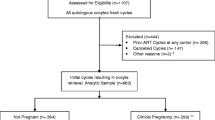Abstract
Purpose: Our purpose was to demonstrate the feasibility of the routine aspiration of supernumerary follicles in infertile patients with imminent polyovulation after ovulation induction with gonadotropins and to examine its effect on the frequency of cycle cancellation and on the (multiple) pregnancy rate.
Methods: The data on 796 treatment cycles, performed between 1989 and 1996 on 410 infertile couples, were analyzed retrospectively. From October 1992, whenever necessary, supernumerary ovarian follicles were selectively aspirated transvaginally under ultrasound guidance to prevent the ovulation of more than three follicles. Thereafter, intrauterine insemination was performed.
Results: After the adoption of transvaginal ultrasound-guided aspiration of supernumerary follicles into the treatment protocol in October 1992, the number of canceled cycles (P < 0.0001) and the multiple pregnancy rate (P < 0.01) were significantly reduced compared to those previously. The overall pregnancy rate remained stable. No ovarian hyperstimulation syndrome requiring hospitalization was noted, and no complications resulting from the follicle aspiration were registered.
Conclusions: Transvaginal ultrasound-guided aspiration of supernumerary ovarian follicles increases both the efficacy and the safety of ovulation induction with gonadotropins. Because of the limited equipment required, this method represents an alternative for conversion of overstimulated cycles to more costly alternatives such as in vitro fertilization.
Similar content being viewed by others
REFERENCES
Levene MI, Wild J, Steer P: Higher multiple births and the modern management of infertility in Britain. Br J Obstet Gynaecol 1992;99:607–613
Tuppin P, Blondel B, Kaminski M: Trends in multiple deliveries and infertility treatments in France. Br J Obstet Gynaecol 1993;100:383–385
Wilcox LS, Kiely JL, Melvin CL, Martin MC: Assisted reproductive technologies: estimates of their contribution to multiple births and newborn hospital days in the United States. Fertil Steril 1996;65:361–366
Garel M, Blondel B: Assessment at 1 year of the psychological consequences of having triplets. Hum Reprod 1992;7:729–732
James WH: Are “natural” twinning rates continuing to decline? Hum Reprod 1995;10:3042–3044
Staessen C, Janssenswillen C, Van Den Abbeel E, Devroey P, Van Steirteghem AC: Avoidance of triplet pregnancies by elective transfer of two good quality embryos. Hum Reprod 1993;8:1650–1653
Gissler M, Silverio MM, Hemminki E: In vitro fertilization pregnancies and perinatal health in Finland 1991–1993. Hum Reprod 1995;10:1856–1861
FIVNAT: Grossesses multiples. Contracept Fertil Sex 1995;23:494–497
Roest J, van Heusden AM, Verhoeff A, Mous HVH, Zeilmaker GH: A triplet pregnancy after in vitro fertilization is a procedure-related complication that should be prevented by replacement of two embryos only. Fertil Steril 1996;67:290–295
Dodson WC, Hughes Jr. CL, Haney AF: Multiple pregnancies conceived with intrauterine insemination during superovulation: An evaluation of clinical characteristics and monitored parameters of conception cycles. Am J Obstet Gynecol 1988;159:382–385
Hazout A, Porchier J, Frydman R: Une alternative à la réduction embryonnaire: la réduction folliculaire. Gynécologie 1984;35:119–121
Belaisch-Allart J, Belaisch J, Hazout A, Testart J, Frydman R: Selective oocyte retrieval: A new approach to ovarian hyperstimulation. Fertil Steril 1988;50:654–656
Ingerslev HJ: Selective follicular reduction following ovulation induction by exogenous gonadotrophins in polycystic ovarian disease. A new approach to treatment. Hum Reprod 1991;6:682–684
De Geyter Ch, De Geyter M, Castro E, Bals-Pratsch M, Nieschlag E, Schneider HPG: Experience with transvaginal ultrasound-guided aspiration of supernumerary follicles for the prevention of multiple pregnancies after ovulation induction and intrauterine insemination. Fertil Steril 1996;65: 1163–1168
De Geyter Ch, Bals-Pratsch M, Doeren M, Yeung C-H, Grunert JH, Bordt J, Schneider HPG, Nieschlag E: Human and bovine cervical mucus penetration as a test of sperm function for in vitro fertilization. Hum Reprod 1988;3:948–954
Macnamee MD, Howles CM, Edwards RG, Taylor PJ, Elder KT: Short-luteinizing hormone-releasing hormone agonist treatment: prospective trial of a novel ovarian stimulation regimen for in vitro fertilization. Fertil Steril 1989;52:264–269
Kamrava MM, Seibel MM, Berger MJ, Thompson I, Taymor ML: Reversal of persistent anovulation in polycystic ovarian disease by administration of chronic low-dose follicle-stimulating hormone. Fertil Steril 1982;37:520–523
World Health Organisation: Laboratory Manual for the Examination of Human Semen and Semen-Cervical Mucus Interaction, 3rd ed. Cambridge, Cambridge University Press, 1992
Kerin JFP, Peek J, Warnes GM, Kirby C, Jeffrey R, Matthews CD, Cox LW: Improved conception rate after intrauterine insemination of washed spermatozoa from men with poor quality semen. Lancet 1984;1:533–535
te Velde ER, van Kooy RJ, Waterreus JJH: Intrauterine insemination of washed husband's spermatozoa: A controlled study. Fertil Steril 1989;51:182–185
De Geyter Ch, De Geyter M, Castèl AM, Meschede D: Assisted fertilization. In Andrology. Male Reproductive Health and Dynsfunction, E Nieschlag, HM Behre (eds). Berlin, Springer Verlag, 1996, pp 323–346
Chaffkin LM, Nulsen JC, Luciano AA, Metzger DA: A comparative analysis of the cycle fecundity rates associated with combined human menopausal gonadotropin (hMG) and intrauterine insemination (IUI) versus either hMG or IUI alone. Fertil Steril 1991;55:252–257
DiMarzo SJ, Kennedy JF, Young PE, Hebert SA, Rosenberg DC, Villanueva B: Effect of controlled ovarian hyperstimulation on pregnancy rates after intrauterine insemination. Am J Obstet Gynecol 1992;166:1607–1613
Serhal PF, Katz M, Little V, Woronowski H: Unexplained infertility—The value of Pergonal superovulation combined with intrauterine insemination. Fertil Steril 1988;49:602–606
Ho PC, So WK, Chan YF, Yeung WSB: Intrauterine insemination after ovarian stimulation as a treatment for subfertility because of subnormal semen: A prospective randomized controlled trial. Fertil Steril 1992;58:995–999
Ransom MX, Doughman NC, Garcia AJ: Menotropins alone are superior to a clomiphene citrate and menotropin combination for superovulation induction among clomiphene citrate failures. Fertil Steril 1996;65:1169–1174
Schenker JG, Yarkoni S, Granat M: Multiple pregnancies following induction of ovulation. Fertil Steril 1981;35:105–123
Jones GS: Update on in vitro fertilization. Endocr Rev 1984;5:62–75
Templeton A, Fraser C, Thompson B: Infertility—Epidemiology and referral practice. Hum Reprod 1991;6:1391–1393
Author information
Authors and Affiliations
Rights and permissions
About this article
Cite this article
De Geyter, C., De Geyter, M. & Nieschlag, E. Low Multiple Pregnancy Rates and Reduced Frequency of Cancellation After Ovulation Induction with Gonadotropins, If Eventual Supernumerary Follicles Are Aspirated to Prevent Polyovulation. J Assist Reprod Genet 15, 111–116 (1998). https://doi.org/10.1023/A:1023000719569
Issue Date:
DOI: https://doi.org/10.1023/A:1023000719569



